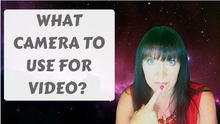- in Video
- |
- 1 comments
Best Camera To Use For Video?

Hi, I’m Michelle Eaton, and today, I’d like to talk to you about what camera to use when you’re getting started with video.The best camera to use, initially, is the camera that you’ve got with you… so your smartphone, basically. Most of the later phones all shoot in HD, and they’re great quality. Some of the latest tablets also shoot in HD.
Listen/Subscribe to the Podcast…
In this ‘Getting Started With Video Series’, I address the the biggest concerns my audience have with using video in their business. ‘What Is The Best Camera To Use For Video’ is the first of these.
Remember to turn your phone or tablet landscape… to the side, landscape, so that you’re shooting in wide screen effectively, when you record your video. This will prevent you having the black borders either side of your video when you load it into YouTube.
Now, you can use a flip cam, or a camcorder… a camera that you already own. I’ve still got a Kodak Zi8, that I used to love… I used to use it constantly, and they’re perfectly fine too. Just make sure, if you’ve got another camera, it’s quite important to have a socket for an external microphone. So, we’re not going to be talking about microphones or audio today, but just something to bear in mind that if it hasn’t got an external socket… an external input for a microphone, then I’d suggest sticking to your smartphone.
Now, you can use a webcam, as long as it’s good quality. This one, now for instance I’m using, is the Logitech C920. Most inbuilt webcams aren’t good enough, so you really need an external webcam for that. The Logitech C920 sells on Amazon for around $45.
You can use a GoPro, or a similar action camera, if you’ve got one. They’ll shoot in HD too, and I know that’s got an external microphone input, as well.
You can use a DSLR, if you have one, but it’s very unlikely you’ve got one, if you’re just starting out. It’s also not really for the beginner… there’s a learning curve.
You can do a certain amount of color correction, and other types of editing, when you’ve finished, and you bring your footage into your editing software.
The next thing to be aware of, is where the lens is in your camera, so be sure to look into the lens, not at the screen. If you need to, draw on a little bit of paper, an arrow, and point it at your lens, just to remind yourself that that’s where, really, your eyes should be looking, not at the screen or wherever your screen may be placed, or a teleprompter, or anything like that. Do your best, and you’ll get better at that with practice. Do your best, and look right into the lens.
The other thing you can do, if you find it difficult, which most of us do find it difficult to talk into a little black hole, is to put a little picture, or have nearby a picture of a friend of yours, or an ideal client… somebody who supports what you’re doing, and appreciates what you’re doing, and then you can feel like, rather than just talking to an inanimate piece of equipment, you’re talking to a person, and you’re explaining just to that one person, and not sort of being all wooden, and that kind of thing.
Whichever camera you choose to start with, you’re going to need something to stand it on. You don’t want to hold it in your hand. You can use a selfie stick, especially if you’re going to move around a little bit; that can be effective for B-roll footage, which is a kind of complementary action footage that you can slot into a video. And that helps with the variety and entertainment, or getting a point across about something, and a GoPro is obviously really good for that as well, but you are going to need something, generally, to stabilize the camera.
Your camera needs to be at eye level, or just slightly above, and make sure the lens is clean. Most cameras will attach to a standard tripod. For your phone, you’ll need a little bracket to attach it to a tripod. You can use a little bendy tripod, or a selfie stick… some selfie sticks also have a stand. Or you can use a full sized tripod. If you have to, you can prop it up on something. That’s not really ideal, but you can do when you’re starting out. Most important thing is, obviously, to get started. A webcam can sit on top of your monitor. If it’s on a laptop, that would probably be too low, so you’d have to raise your laptop to compensate for that. If you’re sometimes glancing at notes on your screen, this is actually an advantage over putting your webcam higher on a tripod, because your eyes won’t be moving away from the camera so much. Also, another point is that if you are looking at something else, referring to something else, the further away from the camera you are, the less obvious that eye movements will be.
Whatever camera you’re starting with, you should know, that the content you’re delivering, the audio and also the lighting are all far more important than the camera you use, so do bear that in mind, and get started!
So, I’d love to hear what you think. Please do leave me a comment below and let me know, and if you’d like to grab my free report listing all of the video equipment that I use, please visit michelleeaton.com/video.So, thanks very much for listening, and I’ll catch you next time!